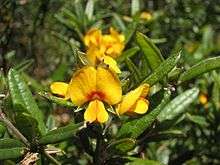Podolobium alpestre
Podolobium alpestre, commonly known as alpine shaggy-pea, is a shrub which is native to south-eastern Australia . The species is a member of the family Fabaceae and of the genus Podolobium. It grows up to 1.3 metres high The leaves are 10 to 40 mm long, 3 to 10 mm wide.[2] The yellow-orange pea-shaped flowers are produced in terminal or axillary racemes between December and January in the species' native range.[2][3]
| Podolobium alpestre | |
|---|---|
 | |
| Podolobium alpestre, Baw Baw National Park, Victoria | |
| Scientific classification | |
| Kingdom: | |
| (unranked): | |
| (unranked): | |
| (unranked): | |
| Order: | |
| Family: | |
| Genus: | |
| Species: | P. alpestre |
| Binomial name | |
| Podolobium alpestre | |
| Synonyms | |
| |
The species was first formally described by botanist Ferdinand von Mueller in his paper Definitions of rare or hitherto undescribed Australian Plants, chiefly collected within the boundaries of the colony of Victoria which was published in 1855. Mueller gave it the name Oxylobium alpestre. The species was transferred to the genus Podolobium in 1995.[1]
It occurs in alpine heaths and high-altitude woodland in Victoria, New South Wales and the Australian Capital Territory.[1][2][3]
External links
References
- "Podolobium alpestre". Australian Plant Name Index (APNI), IBIS database. Centre for Plant Biodiversity Research, Australian Government, Canberra. Retrieved 12 December 2009.
- Costermans, L. (1981). Native Trees and Shrubs of South-eastern Australia. Australia: Rigby. ISBN 978-0727014030.
- "Podolobium alpestre". PlantNET - New South Wales Flora Online. Royal Botanic Gardens & Domain Trust, Sydney Australia. Retrieved 12 December 2009.